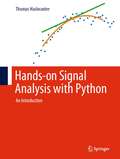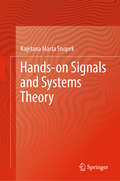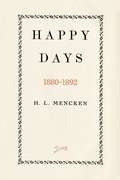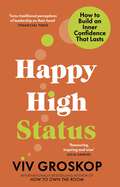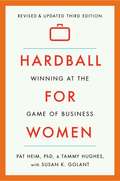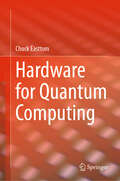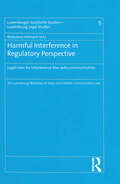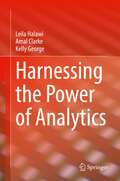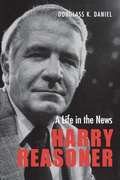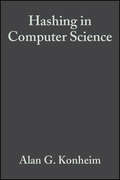- Table View
- List View
Hands-on Signal Analysis with Python: An Introduction
by Thomas HaslwanterThis book provides the tools for analyzing data in Python: different types of filters are introduced and explained, such as FIR-, IIR- and morphological filters, as well as their application to one- and two-dimensional data. The required mathematics are kept to a minimum, and numerous examples and working Python programs are included for a quick start. The goal of the book is to enable also novice users to choose appropriate methods and to complete real-world tasks such as differentiation, integration, and smoothing of time series, or simple edge detection in images. An introductory section provides help and tips for getting Python installed and configured on your computer. More advanced chapters provide a practical introduction to the Fourier transform and its applications such as sound processing, as well as to the solution of equations of motion with the Laplace transform. A brief excursion into machine learning shows the powerful tools that are available with Python. This book also provides tips for an efficient programming work flow: from the use of a debugger for finding mistakes, code-versioning with git to avoid the loss of working programs, to the construction of graphical user interfaces (GUIs) for the visualization of data. Working, well-documented Python solutions are included for all exercises, and IPython/Jupyter notebooks provide additional help to get people started and outlooks for the interested reader.
Hands-on Signals and Systems Theory
by Kajetana Marta SnopekThis textbook presents the theory of continuous-time and discrete-time signals and systems and shows how it can be used to solve analytically different problems. The book is dedicated to engineering students who are interested in mathematical methods used to solve real technical problems connected with signals and systems. The book covers, both in continuous- and in discrete domains, analysis of signals in time domain; orthogonal signal representation including Fourier series; convolution and correlation of signals; analysis of signals in the frequency domain and signal sampling, including aliasing and stroboscopic effects, among others. The author also emphasizes the role of Fourier-, one-sided Laplace- and one-sided Z transformations in signals and systems. Chosen methods of analog and digital filter design and stability criteria of analog and digital filters are also described. The author presents the necessary theory in the form of a concise “lecture” accompanied with a number of solved original problems. Every chapter ends with examples of complete solutions with explanation and necessary graphical visualization (graphs, schemes etc.).
Handwriting
by Peter WestDo you realize how revealing your handwriting is? Whenever you put pen to paper - whether applying for a job, addressing an envelope or merely doodling - you may be giving away much more about yourself than you intend.In this highly readable and authoritative guide, graphologist Peter West uses over 300 illustrations to analyse:-General features - slant, size and margin-Specifics - capitals, numbers, signatures and choice of ink and paper colour-Doodles - what is the secret of your absent-minded designs?-The letters of the alphabet - identifying the main stylistic variationsIt includes illuminating sections on graphology as an aid to:-Assessing compatibility in relationships-Personal management-Child guidanceHandwriting provides a fascinating and invaluable chance to better understanding yourself and others.
Happier Together: How to Find Your People & Make Friends That Last
by Lori WhatleyHappier Together is a must-read exploration of the transformative power of authentic human connection and the detrimental effects of loneliness.Happier Together celebrates the value of friendships at every stage of life and their role in creating a strong foundation for health, happiness, and longevity. Essential for anyone looking to overcome loneliness, Happier Together details the how, when and where to find friends, start new relationships and nurture existing connections.Discover in these pages:• The Transformative Power of Connection: How meaningful connections improve well-being and longevity.• Health Risks of Loneliness: The severe physical and mental health risks associated with social isolation.• Importance of Friendships: The critical role of friendships in living a long and fulfilling life.• Research-Based Insights: Evidence-based findings on the impact of social media on mental health and interpersonal relationships.• Practical Advice: Strategies for building and maintaining strong, supportive relationships.In today's world, we can often feel disconnected and lonely. Our interactions are increasingly digital, leading to impersonal interactions that fail to satisfy our essential need for real connection.Happier Together is a powerful reminder that fostering meaningful relationships is essential for our well-being. By understanding the importance of friendship and actively working to build and maintain these connections, we can lead longer, more fulfilling lives.
Happiness in Journalism
by Mark Deuze Claudia Mellado Valérie Bélair-Gagnon Avery E. HoltonThis book examines how journalism can overcome harmful institutional issues such as work-related trauma and precarity, focusing specifically on questions of what happiness in journalism means, and how one can be successful and happy on the job. Acknowledging profound variations across people, genres of journalism, countries, types of news organizations, and methodologies, this book brings together an array of international perspectives from academia and practice. It suggests that there is much that can be done to improve journalists’ subjective well-being, despite there being no one-size-fits-all solution. It advocates for a shift in mindset as much in theoretical as in methodological approaches, moving away from a focus on platforms and adaptation to pay real attention to the human beings at the center of the industry. That shift in mindset and approach involves exploring what happiness is, how happiness manifests in journalism and media industries, and what future we can imagine that would be better for the profession. Happiness is conceptualized from both psychological and philosophical perspectives. Issues such as trauma, harassment, inequality, digital security, and mental health are considered alongside those such as precarity, recruitment, emotional literacy, intelligence, resilience, and self-efficacy. Authors point to norms, values and ethics in their regions and suggest best practices based on their experience. Constituting a first-of-its-kind study and guide, Happiness in Journalism is recommended reading for journalists, educators, and advanced students interested in topics relating to journalists’ mental health and emotion, media management, and workplace well-being. This book is accompanied by an online platform which supports videos, exercises, reports and links to useful further reading.
Happiness the Mindful Way
by Ken A. VerniHappiness: The Mindful Way is a practical step-by-step guide to help focus the mind, improve performance, and be happy.This easy-to-follow, step-by-step guide is filled with infographics and questionnaires, making the road to happiness an enjoyable, personal journey. Discover how breathing techniques, body scanning, and simple meditation can help you be in the present moment, lessen anxiety, and distance yourself from damaging emotions. The range of methods presented makes it easy to tailor a program to fit your needs.From coping with anxiety to breaking bad habits to making a speech in front of a crowd, Happiness: The Mindful Way offers foolproof methods and expert advice for gaining resilience, confidence, and communication skills, and becoming more successful in the pursuit of your goals.
Happiness--Found in Translation: A Glossary of Joy from Around the World
by Tim LomasA beautifully illustrated dictionary of words from around the world that describe experiences of happiness for which there are no equivalents in the English language.Have you ever had a feeling that you couldn't quite describe because there was no word in English that captured it? Our ability to fully experience moments of joy in our lives can be limited by the words at our disposal. In this magical book, psychologist Tim Lomas surveys words from around the world to help readers put their finger on feelings of happiness that before might have lingered for only a moment in their mind's eye before disappearing. The ideal gift for language lovers, or for anyone looking for a megadose of pure joy, Happiness--Found in Translation features such "untranslatable" words as:Bazodee: A Creole (Trinidad and Tobago) word to describe a dizzy and dazed happiness, a bewildered, discombobulated joy.Charmolypi: A Greek word for the sad, joy-making sorrow when happiness and sadness intermingle.Wú wéi: A Chinese term for natural, spontaneous, and effortless action, skilfully flowing with the currents of life.Happiness--Found in Translation gives readers access to the great happiness that the world's languages have to offer.
Happy Days Were Here Again: Reflections of a Libertarian Journalist
by William F. Buckley Jr.In "Happy Days Were Here Again", William F. Buckley Jr. offers a collection of his finest essays from the latter part of his long career. Sometimes celebrating, sometimes assailing, Buckley takes on opponents ranging from Mikhail Gorbachev to Carl Sagan to Leonard Bernstein; reflects on the academic scene, the Gulf War, and the idea of sin; and offers appreciations of friends, both right and left. For everyone who appreciates the wit and style of America's preeminent conservative, this is a must-have collection.
Happy Days: 1880-1892 (H.L. Mencken's Autobiography)
by H. L. MenckenWith a style that combined biting sarcasm with the "language of the free lunch counter," Henry Louis Mencken shook politics and politicians for nearly half a century. Now, fifty years after Mencken's death, the Johns Hopkins University Press announces The Buncombe Collection, newly packaged editions of nine Mencken classics: Happy Days, Heathen Days, Newspaper Days, Prejudices, Treatise on the Gods, On Politics, Thirty-Five Years of Newspaper Work, Minority Report, and A Second Mencken Chrestomathy. Most of these autobiographical writings first appeared in the New Yorker. Here Mencken recalls memories of a safe and happy boyhood in the Baltimore of the 1880s.
Happy Days: My Mother, My Father, My Sister & Me
by Shana AlexanderAcclaimed 60 Minutes commentator and true-crime author Shana Alexander turns her journalist&’s eye to her own unconventional family—and herself—in this fascinating, moving memoir Shana Alexander spent most of her life trying to figure out her enigmatic parents. Milton Ager was a famous songwriter whose creations included &“Ain&’t She Sweet&” and &“Happy Days Are Here Again.&” Cecelia Ager was a film critic and Variety columnist. They were a glamorous Jazz Age couple that moved in charmed circles with George and Ira Gershwin, Dorothy Parker, and Jerome Kern. They remained together for fifty-seven years, and yet they lived separate lives. This wise, witty, unflinchingly candid memoir is also a revealing account of Alexander&’s own life, from her successful career as a writer and national-news commentator to her troubled marriages and emotionally wrenching love affairs. She shares insights about growing up with a cold, hypercritical mother, her relationship with her younger sister, the suicide of her adopted daughter, and her reconciliation with her parents after a twenty-year estrangement. &“I had to do a lot of detective work to uncover the truth about my parents&’ lives,&” Alexander said. &“I knew almost nothing about them as people. But by the end they really did become my best friends.&”
Happy High Status: Get the secret to lasting confidence, from the bestselling author of How to Own the Room
by Viv GroskopRedefine what confidence looks like at home and at work.Everyone wants to be able to face challenging situations without feeling daunted, intimidated or stressed. But no-one wants to be labelled over-confident, arrogant or smarmy, or to get caught up in their own hype. So how can you feel authentically confident - without the cringe, and without pretending to be something you're not?Happy high status is a new way of thinking about confidence and how you relate to yourself. It's how actors and comedians enhance their presence on stage and screen. It lends strength and energy to your interactions, big and small, and is a way of projecting status, minimising self-doubt and moving effortlessly through life.Drawing on research, practical tips and lessons from the worlds of comedy, film, television, politics and sport, Viv Groskop offers a masterclass in how you can access this new form of confidence at any time. All, crucially, with no risk of anyone thinking that you are your own biggest fan."Viv always makes me feel more confident. Get the magic now in book form" - Katy Brand"I recommend Viv Groskop to anyone wanting more self-confidence" - Philippa Perry"Reassuring, inspiring and wise - a practical handbook for anyone held back by self-doubt" - Julia Samuel
Happy Mum, Happy Baby: My adventures into motherhood
by Giovanna FletcherCONTAINS A BRAND NEW CHAPTERSunday Times Number One Bestseller Happy Mum Happy Baby is now a Number One podcast. A positive and uplifting book about what it is to be a mother and all things mum and baby by Celebrity Mum of the Year and phenomenally popular vlogger, author, TV presenter and actress Giovanna Fletcher.Being a mum is an incredible journey, a remarkable experience that changes how we look, how we feel, who we are. As mothers we are strong, protective, proud. We feel a love like no other.But being a parent can be hard too. It challenges us physically, mentally, emotionally. There are the days where just managing to fit a shower in amidst the endless feeding, entertaining young children and surviving on a lack of sleep feels like an achievement. With so many people ready to offer 'advice' on the best way to parent, it can feel like you are getting it all wrong.Since Giovanna and her husband Tom Fletcher have had their sons Buzz and Buddy, they have been sharing glimpses of their family life. With an infectiously positive outlook and happy take on all things mum-related, Giovanna has developed a following of fellow parents and mums-to-be.This is not a book about how to have the perfect family experience - Gi would be the first to admit she is winging it just as much as the rest of us - instead it is an honest, upbeat and incredibly personal account of her own experience of having a family. In Happy Mum, Happy Baby Giovanna shares her own journey through parenthood and in doing so, she looks at what it is to be a mother today, encourages you to be confident in yourself as a parent and celebrates how putting a focus on being a happy and confident mum can really make for a happy baby.
Happy Mum, Happy Baby: My adventures into motherhood
by Giovanna FletcherBeing a mum is an incredible journey, a remarkable experience that changes how we look, how we feel, who we are. As mothers we are strong, protective, proud. We feel a love like no other.But being a parent can be hard too. It challenges us physically, mentally, emotionally. There are the days where just managing to fit a shower in amidst the endless feeding, entertaining young children and surviving on a lack of sleep feels like an achievement. With so many people ready to offer 'advice' on the best way to parent, it can feel like you are getting it all wrong.Since Giovanna and her husband Tom Fletcher have had their sons Buzz and Buddy, they have been sharing glimpses of their family life. With an infectiously positive outlook and happy take on all things mum-related, Giovanna has developed a following of fellow parents and mums-to-be.This is not a book about how to have the perfect family experience - Gi would be the first to admit she is winging it just as much as the rest of us - instead it is an honest, upbeat and incredibly personal account of her own experience of having a family. In Happy Mum, Happy Baby Giovanna shares her own journey through parenthood and in doing so, she looks at what it is to be a mother today, encourages you to be confident in yourself as a parent and celebrates how putting a focus on being a happy and confident mum can really make for a happy baby.(P)2017 Hodder & Stoughton
Hard Feelings: Reporting on Pols, the Press, People and New York
by Ken AulettaKen Auletta's memoir about his time as a reporter.
Hardball for Women
by Susan K. Golant Pat HeimIn Hardball for Women, Pat Heim shows women how to break patterns of behavior that have put them at a disadvantage in the business world of men. Whether the arena is a law firm, a medical group, a corporation, or any other work environment, Hardball for Women decodes the male business culture and gives readers strategies on how to use its rules to get ahead--and stay ahead. Readers will learn to: Be assertive without being obnoxious Display confidence Engage in smart self-promotion Lead both men and women--and recognize the differences between them Use "power talk" language to your advantage
Hardball for Women
by Susan K. Golant Pat Heim Tammy HughesThe bestselling guide fully updated for the post-Lean In era For nearly two decades, Hardball for Women has shown women how to get ahead in the business world. Whether the arena is a law firm, a medical group, a tech company, or any other work environment, Hardball for Women decodes male business culture and shows women how to break patterns of behavior that put them at a disadvantage. It explains how to get results when you "lean in" without being thrown off balance. Illustrated with real-life examples Hardball for Women teaches women how to:Successfully navigate middle management to become a leader in your fieldBe assertive without being obnoxiousDisplay confidenceEngage in smart self-promotionLead both men and women--and recognize the differences between themUse "power talk" language to your advantage
Hardball for Women: Winning at the Game of Business
by Susan K. Golant Pat HeimFrom the book: "The majority of women in the business world today are oblivious to the fact that they are standing on a playing field while a game is being played around them. Until you realize that business is conducted as a sport, you'll never move ahead and you'll never win" --PAT HEIM Exploring from the ground up how boys and girls are taught to behave, author Pat Heim uses her extensive experience in the business world and a wide variety of research to show you how your behavior is interpreted to determine whether you are strong or weak, clear or vague, ambitious or passive, and, ultimately, promotable or not. Then she shows you how to understand the game of business and how to build on that understanding to succeed in your career. You'll master the following skills: How to lead men, and how to lead women. How to turn criticism and praise to your advantage. How to display confidence and power even when you feel frightened and powerless. How to be on either end of an attack during a business meeting and still remain cordial later. How to offer help so you're not seen as obstructionist. How to take risks. (continued from front flap) How to distinguish between the male and female version of a "team player." How to work with people you don't like. How to hide your vulnerability. The goal of Hardball for Women is to let you act rather than react, to help you see the rules that men play by and use them to meet your own goals, to make you feel comfortable, even exhilarated, with playing the competitive game. This book will give you the strategies that have worked to bring success in business.
Hardware for Quantum Computing
by Chuck EasttomThis book covers extensively the physical implementation of qubits and quantum architecture. The author demonstrates how quantum computing is implemented by the underlying physical implementation of qubits, including trapped ions, nitrogen vacancy centers, frozen neon, and other implementations. The book shows how, ultimately, the physical implementation of the qubit is the foundation of quantum computing, and that the choice of physical qubit will impact such things as decoherence times, computational efficiency, and even error rate. The book explores all the current approaches to physical qubit implementation and includes appendices that review basic quantum computing and physics.
Harmful Interference in Regulatory Perspective: Legal rules for interference-free radio communication
by Mahulena HofmannThis collection analyses the regulatory aspects of harmful interference faced by those entities operating space communication and broadcasting. While technology reacts to this international phenomenon with the development of continuously improving technological systems for preventing and combating harmful interference, its international regulatory and legal framework develops at a much slower pace. Issues discussed include the increasing deterioration of signals from broadcasting and communication satellites, including cases of intentional interference known as `jamming’; the human rights balance between freedom of expression and protection from hate speech; the efficacy of the current regulatory system and the legal consequences of non-compliance; the role of national authorities, and supranational bodies such as the EU and UN. The contributors include experts drawn from international and national academia, the ITU, national regulatory authorities and operators to present an international, multidimensional, and critical analysis of this complex phenomenon.
Harnessing the Power of Analytics
by Leila Halawi Amal Clarke Kelly GeorgeThis text highlights the difference between analytics and data science, using predictive analytic techniques to analyze different historical data, including aviation data and concrete data, interpreting the predictive models, and highlighting the steps to deploy the models and the steps ahead. The book combines the conceptual perspective and a hands-on approach to predictive analytics using SAS VIYA, an analytic and data management platform. The authors use SAS VIYA to focus on analytics to solve problems, highlight how analytics is applied in the airline and business environment, and compare several different modeling techniques. They decipher complex algorithms to demonstrate how they can be applied and explained within improving decisions.
Harry Reasoner: A Life in the News
by Douglass K. DanielHarry Reasoner was one of the most trusted and well-liked journalists of the golden age of network television news. <P><P>Whether anchoring the evening newscast on CBS in the 1960s or on ABC in the 1970s, providing in-depth reporting on 60 Minutes, or hosting numerous special programs covering civil rights struggles, the Vietnam War, and Watergate, Reasoner had "that almost mystical quality it seems to take for good television reporting, exuding this atmosphere of truth and believability," in the words of Walter Cronkite. Yet his reassuring manner and urbane, often witty, on-air persona masked a man who was far more complex and contradictory. Though gifted with the intelligence and drive to rise to the top of his profession, Reasoner was regarded by many colleagues as lazy and self-indulgent, a man who never achieved his full potential despite his many accomplishments.
Harry the Hopper: Targeting the h Sound (Speech Bubbles 2)
by Melissa PalmerHarry loves to hop, and believes he is a ‘hopper’ – but not everyone agrees… This picture book targets the /h/ sound and is part of Speech Bubbles 2, a series of picture books that target specific speech sounds within the story. The series can be used for children receiving speech therapy, for children who have a speech sound delay/disorder, or simply as an activity for children’s speech sound development and/or phonological awareness. They are ideal for use by parents, teachers or caregivers. Bright pictures and a fun story create an engaging activity perfect for sound awareness. Picture books are sold individually, or in a pack. There are currently two packs available – Speech Bubbles 1 and Speech Bubbles 2. Please see further titles in the series for stories targeting other speech sounds.
Harry's Story: A Picture Book To Raise Awareness Of And Support Children With Dld (Supporting Children with DLD)
by Kate KemptonFor effective use, this book can be purchased alongside the professional guide, Supporting Children with DLD. Both books can be purchased together as a set, Supporting Children with DLD: A Picture Book and User Guide to Learn About Developmental Language Disorder [978-0-367-70920-4]. This beautifully illustrated picture book has been created to develop awareness of Developmental Language Disorder and provides a unique opportunity to sensitively gain children’s perspectives of the condition. Harry enjoys school, but faces daily challenges due to his language difficulties. When he is asked to write a story, he struggles to find the words to put his thoughts onto paper. He learns to share his stories through pictures instead and, in doing so, helps his supportive teacher understand what she can do to make life easier for him. With bright illustrations and language that can be accessed by children with DLD, this story can be used to start conversations about the lived experience of children with Developmental Language Disorder, giving them a voice and helping them express their thoughts and feelings. It can also be used as a training tool for teachers and other professionals. This is an essential resource for parents and practitioners looking to understand and support children with DLD.
Hash House Lingo: The Slang of Soda Jerks, Short-Order Cooks, Bartenders, Waitresses, Carhops and Other Denizens of Ye
by Paul Dickson Scott Russo Jack SmileyOriginally published in 1941, this pocket-sized treasury preserves the language of diners and roadside restaurants during their golden age in the '30s and '40s. From "all hot" (baked potato) and "dog soup" (water) to "perk" (coffee) and "first lady" (spare ribs), the long-lost terms are fascinating, funny, and sometimes politically incorrect by today's standards. Historic photos from the Library of Congress add nostalgic appeal.
Hashing in Computer Science
by Alan G. KonheimWritten by one of the developers of the technology, Hashing is both a historical document on the development of hashing and an analysis of the applications of hashing in a society increasingly concerned with security. The material in this book is based on courses taught by the author, and key points are reinforced in sample problems and an accompanying instructor s manual. Graduate students and researchers in mathematics, cryptography, and security will benefit from this overview of hashing and the complicated mathematics that it requires.
